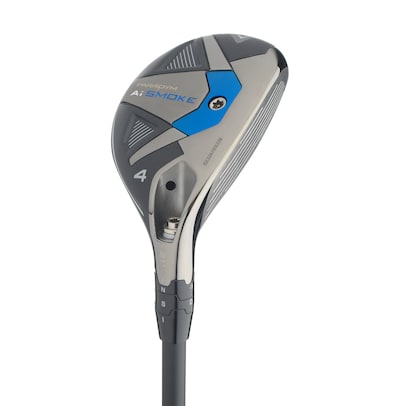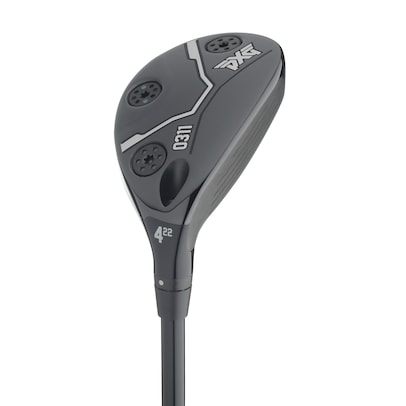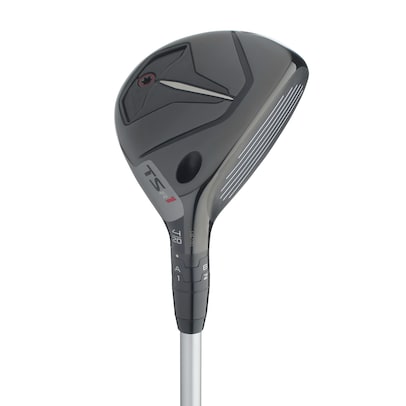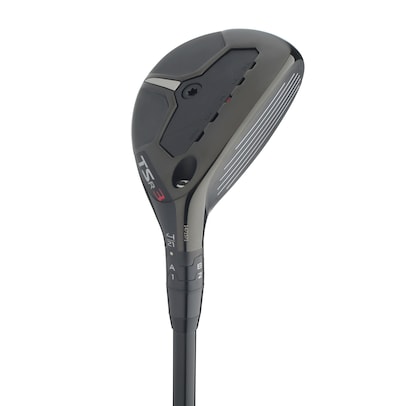Hot List
Best Hybrids of 2024
As long irons fade out, hybrids are going deeper into many golfers’ bags. Why do some manufacturers offer lofts as high as an 8-hybrid? It’s because they tend to be easier to hit than a hanging curveball and continue to absorb the workload normally performed by even middle irons. However, some hybrids can be mini fairway woods in disguise, making for a viable option for those seeking a touch more control from the fairway. Whether iron or fairway-wood replacement, one this is clear: hybrids are thriving.

Targeting players with average to high swing speeds, this full-service hybrid aims to find a little more distance and tighter dispersion with its AI-generated face design. The weighting and shaping accentuate this player’s needs, including a tungsten weight that pushes the balance of the head forward and deep to calm distance-robbing spin and to promote an efficient energy transfer at impact. The larger shape provides extra forgiveness on mis-hits, and the sole camber extends that forgiveness to turf interaction.

Don’t focus so much on the lofts on this hybrid, which are the same as those on the standard Ai Smoke. Because the shafts here are progressively longer with more tip flexibility and because these heads are designed with a lower center of gravity through a wider sole and a shallower face height, the HL model, as its name implies, should provide a higher launch angle. The tungsten in the front part of the sole assists in giving these players even more height.

Having a hot, flexible face is important, and Callaway has long used machine learning to achieve this, but that doesn’t matter if golfers can’t generate their own speed. This hybrid can be just what moderate-swing-speed players need. It’s 30 grams lighter than the standard model and has a more streamlined design. Callaway pulls this off in part by removing the adjustable hosel, which also frees up mass to sit lower in the head for more efficient energy transfer at impact. The shallow profile also makes it easier to get the ball in the air.

For all its complexity (titanium construction, carbon-composite crown, a mineshaft’s worth of tungsten, artificial intelligence-designed face), the Super Hybrid poses a simpler question: What if a hybrid was designed to replace not an iron but a fairway wood? The result is this super-charged hybrid with a driver-like titanium face. The large frame offers off-center-hit forgiveness, and the 91 grams of tungsten in the sole fuel easier launch. The shorter shafts also go a long way to making you question the need for fairway woods at all.

Like a 320-pound left tackle who knows his way around a three-dimensional torus network, these hybrids might be that ideal combination of size and smarts. Oversize in volume and face area, they take that stability and boost ball speed by alternating the stiff and flexible regions in the front part of the crown. Inside, computer analytics optimized the location and size of weight pads in the sole and perimeter to maximize forgiveness and improve launch. Computer-simulated attack angles of average golfers even determined the degree of taper on the sole rails.

We get that making a hybrid with a trampoline face is desirable, but all that ball speed without the ability to launch the ball isn’t much use. The ideal hybrid needs its internal weight to be low to boost that launch angle. Darkspeed uses an ingenious internal bridge-like weight bar low and close to the face to make it easier to launch shots high. At the same time, this structure allows the thin face to wrap around the leading edge for maximum ball speed.

When you hire a handyman, you expect him to be able to carry an armload of two-by-fours, bring his own tools and dang sure drive a tricked-out F-150. The busting-out-of-its-flannel-shirt King Tec is that sort of hybrid handyman. With three adjustable weights, a light carbon-composite crown and a high-strength steel face insert, this brute is ready to go to work regardless of the assignment. The weights, including an adjustable hosel, let you tweak launch, dial in spin and wrench away that slice or hook.

People who quibble over the size of a hybrid don’t know much about the panic of standing over a 180- to 220-yard shot and wondering why you gave up tennis. This oversize model does its best to manage those fears, combining a meaty address view with an encouragingly shallow face. The polymer-filled channel in the sole is the same one used in Mizuno’s driver. On this hybrid, it now stretches all the way to the hosel, providing even more potential distance on off-center hits.

Designed with the tour player in mind but offering enough optional settings to make the blue-collar golfer comfortable, this mid-size model offers a neutral flight but with launch-increasing and spin-reducing low center of gravity. The adjustable hosel pushes the loft range to as low as 14 (for tour players) and as high as 27 (for tour fans). It gives the player who wants to work shots a shape he or she feels comfortable with while providing forgiveness, launch and distance for those just trying to advance the ball.

These hybrids solve your problems so discreetly you might start to believe they are strengths. Suddenly, 4- and 5-iron shots have height and distance because of a wraparound face that increases the flexing area. Carbon composite at the back of the crown drips over the edges of the perimeter to lower the center of gravity so that shots launch easier. With an adjustable loft range of up to 35 degrees, you may never need to hit a middle iron again, much less a long iron.

A thinner, stronger metal in the face typically means faster ball speed. PXG’s engineers believe the new steel alloy—yet to be named—in this hybrid’s face improves ball speed and more. The face is 10.5 percent thinner, but it also produces a higher launch angle with less spin. Combining faster ball speed and better launch conditions is a recipe for distance and, as it turns out, tighter dispersion. That’s some alloy. Maybe PXG should call it Something Else.

With a hybrid’s relatively compact size, finding ways to save weight requires imagination. Using carbon composite to stretch the size of the crown, for example, probably matters more in a hybrid than it does on a driver. (The lightweight material replaces steel, which is heavier than the titanium on a driver.) For the Qi10, this means shifting weight to the perimeter to lower the center of gravity for more distance.

Be honest: You need a hybrid because the last time you hit a 4-iron higher than the roof of your golf cart, you were still carrying a 3-iron. This oversize hybrid addresses your needs with the highest flight in the TaylorMade stable because of a carbon-composite crown that produces a lower center of gravity. The shallow-face height makes this big body more effective, and its size provides more forgiveness across the face.

Like business ethics and jumbo shrimp, “players hybrid” seems like a contradiction. Too often for better players, the help from hybrids is excessive and the draw-bias weighting is a turn-off. But even the best players need help as clubs get longer, and this model portions its aid in the right measure. This includes heel-and-toe internal weighting for consistent distance control and a more squared-off look at address. The compact head fosters workability and an iron-like-hybrid drive through the turf—as contradictory as this sounds.

This hybrid may look more like a fairway wood, but after Titleist engineers studied the potential market for a lightweight hybrid, they found that bigger is better. The wide sole is easier on the typical sweeping strokes made by players at this level, but more importantly this big-body hybrid provides stability on those all-too-common off-center strikes. The screw weight in back builds in dynamic loft to help shots start on a high-flying trajectory. A tip-flexible, shorter fairway-wood shaft provides high launch, and the overall lighter club weight instills control.

Making a hybrid forgiving, which usually requires a deeper center of gravity, can be a problem if it leads to shots drawing too much, especially for faster swings, but TSR2 emphasizes accuracy with its push for distance. A hybrid should be targeting a green just like the iron it replaces. Hence, the wider blade length on the TSR2 offers power and forgiveness and slightly shifts the center of gravity away from the shaft for a more neutral, on-target flight.

If you want to design a better hybrid for good players, you could deploy a team of engineers to dissect the needs of low spin, controlled launch and power. Or maybe you just could ask Steve Stricker, who has been rocking an old-school Titleist 816 H1 hybrid since the Obama administration. When the Titleist team looked at upgrading this better-players model, they focused on the Stricker-played shape. Its lower and forward center of gravity works well with more of a steep, iron-like swing and provides more workability.

Adams Golf did not invent the hybrid, but for a time no company did more to perfect this game-saving club. Adams returns to its roots with a hybrid styled after its best inventions with new enhancements. Its original sole channel (the legendary “velocity slot”) creates extra flexing lower on the face where most average golfers make contact. A new carbon-composite crown lowers the center of gravity and allows for a heel-side screw in the sole for some ever-friendly draw bias.

Hybrids need more than a thin face to generate ball speed. These hybrids have a variable-thickness face, but the main source of power is how the body contributes to that flexibility. Alternating the stiffness and flexibility of the surrounding regions in the body allows the face to become a more efficient conduit for power. Srixon’s team achieves a lower and deeper center of gravity through thicker sole sections for a higher launch and more spin to help shots stick the landing on the green.

When designing a hybrid for better players, the challenge is to provide just the right amount of game-enhancement. If a hybrid exists on a spectrum between a fairway wood and a long iron, this entry is closer to the iron side. The C723 is designed with a more forward center of gravity for players who hit down on the ball like they do with an iron. A 10-gram weight in the front part of the sole keeps shots from launching with too much spin. Its flatter lie angles help to produce a less draw-biased, neutral iron-like flight, too.

Think of a hybrid as a “fixer” or “crisis manager.” The E723 is for average golfers who get into above-average trouble. That’s why the E723 is oversized for extra forgiveness. The wide, angled and versatile sole with heel, toe and rear relief can navigate the nastiest lies. The carbon-composite crown takes weight off the top to place it low and deep, including a 10-gram weight at the trailing edge for higher dynamic loft and more off-center-hit stability.